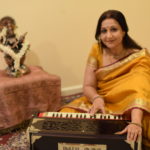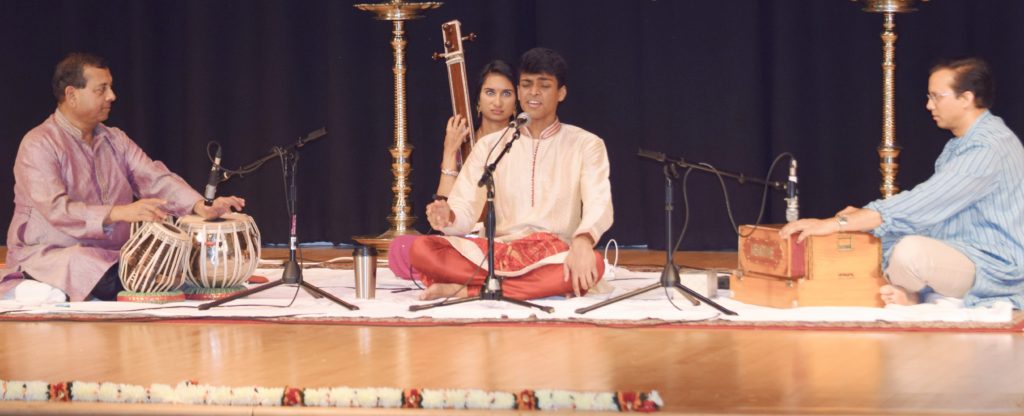By Shailesh Surti
e-mail:Â shailesh.surti@gmail.com
Pittsburghers have witnessed many Arangetrams by young Indian-American dancers. However, we have not witnessed a Manch Pravesh, the first solo recital of Hindustani classical music by a student after years of learning, marking the student’s beginning of a deeper understanding of the art form. Eishan Ashwat‘s Manch Pravesh recital was on June 18 at the Sri Venkateswara Temple Auditorium.
For a young boy growing up in Pittsburgh with no previous exposure to this music, to pursue vocal music with passion, many stars have to align. Eishan found encouragement from his parents, Shirish and Anuradha Ashwat. They live close to Shambhavi Desai (in the inset), a faculty member of the Pandit

Guru Shambhavi Desai
Jasraj Institute of Music (PJIM). She trains under Guru Pandita Tripti Mukherjee. Shambhavi initiated Eishan into vocal music when he was seven. Later, he learned from Pandita Tripti Mukherjee, following the traditions of the Mewati Gharana.
He practiced for countless hours, sometimes with his Guru Shambhavi and with Shambhavi’s husband Pryadarshi Desai, who plays the harmonium. While preparing for the recital, he had guidance from the Sangeet Martand Pandit Jasraj himself.Â
The recital was in front of invited guests well versed in the nuances of Indian vocal music. Eishan gave a full recital, a total of eight compositions in different genres, starting with a Bada Khayal (Khayal in Persian means imagination) in Raga Madhuvanti set to Vilambit (Slow tempo) Ek Taal. He handled the long and serious Bada Khayal, generally sung by the professionals, with ease and elan.
This was followed by a Chhota Khayal in the same Raga set to Teen Taal. Eishan here introduced some complex taans. He used traditional Bandishes (lyrics) for this Raga with sweet and romantic sentiments. The next item was a Khamaj Thumri a light classical piece in Taal Adha.

Eishan next rendered a Dhrupad piece, composed by the legendary musician Tansen, in Raga Vasanat set in Chautaal. The Dhrupad style involves an elaborate aalap, followed with layakari with the rhythm. He then rendered a Haveli Sangeet piece, sung in Vaishnava Temples, a Krishna Bhajan set in taal Deepchandi, followed by a Trivat in Raga Kirwani.
Since his family is from Karnataka, he also recited a  Kannada Bhajan of Purandara Dasa in Raga Bibhas. As is customary, the last piece was in Raga Bhairavi, a Meera Bhajan.
It gives me great pleasure to record that Shri Kulkarni on the Tabla, and Dr. Nadkarni on the Harmonium, both veteran musicians in their own standing, provided encouraging support to Eishan.
The program was well received and enjoyed by all. Hopefully, a few youngsters in the audience were persuaded to take up vocal music. Eishan displayed his versatility by singing in seven ragas set in eight different taals, from the ancient genres of Dhrupad to more recent Khayal, Thumri and Bhajan in his first solo recital.
Eishan knows this is just the beginning of his musical journey. With passion, hard work and guidance from his gurus, he will go far.
Eishan is an Eagle Scout. He just graduated from South Fayette High School with high academic honors. He is going to the University of Pittsburgh in a program that will admit him to the medical school. Staying in Pittsburgh will allow him to continue his training under his Gurus.
Pittsburgh is very fortunate to have PJIM-trained dedicated Adya Gurus of the Mewati Gharana. We look forward to more Manch Praveshes in Pittsburgh by young musicians.   ♣
